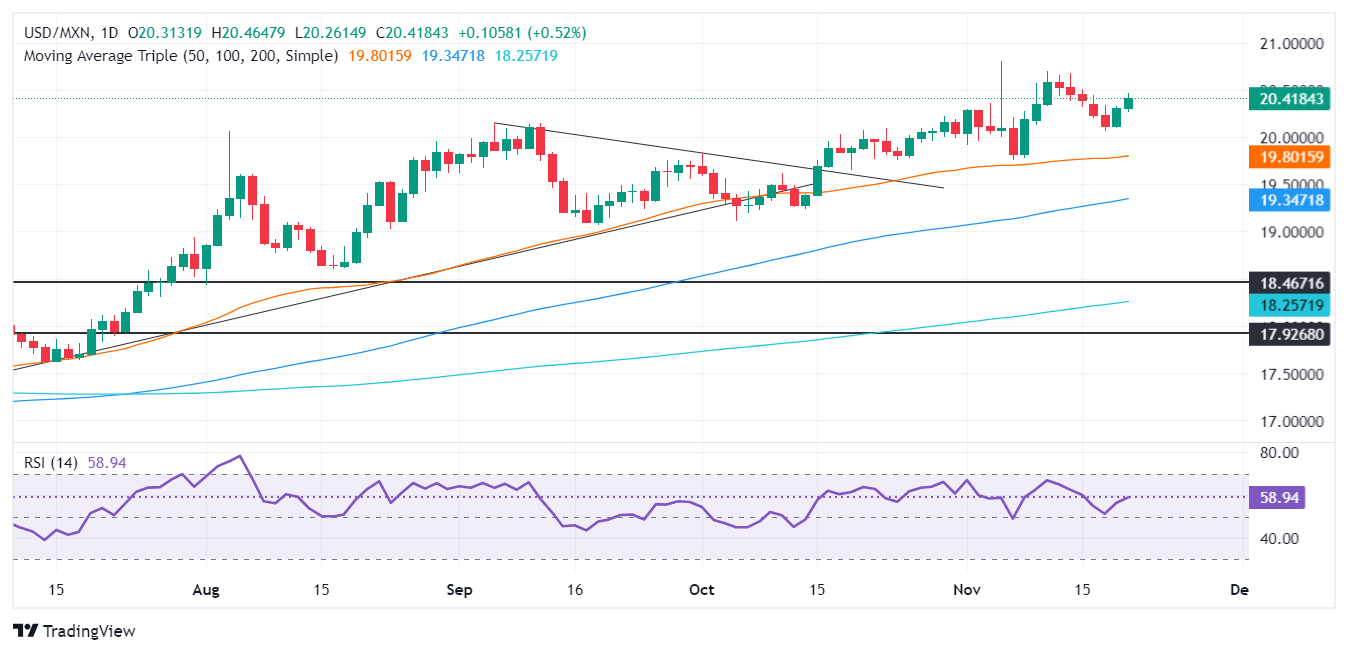Mexican Peso weakens on mixed Retail Sales data, geopolitics jitters
Fxstreet
Nov 21, 2024 5:29 PM
- Mexican Peso falls against the US Dollar amid continued geopolitical concerns and disappointing local data.
- US Dollar Index reaches a new year-to-date high of 107.06.
- Banxico Governor signals potential for further rate cuts, adding pressure on the Peso's short-term outlook.
The Mexican Peso depreciated against the US Dollar on Thursday due to risk aversion as the Russia-Ukraine conflict escalates. Also,a soft Mexican Retail Sales report and solid US jobs data weighed on the emerging market currency, which is down 1.86% in the month. At the time of writing, the USD/MXN trades at 20.39, up 0.71%.
Geopolitics continued to drive price action. Consequently, the Greenback hit a new year-to-date (YTD) high against a basket of six currencies known as the US Dollar Index (DXY). The DXY is up 0.38% near 107.06.
Therefore, the USD/MXN is printing another leg-up after the Instituto Nacional de Estadistica Geografia e Informatica (INEGI) revealed that monthly Retail Sales came in as expected but missed the mark on an annual basis.
Meanwhile, Bank of Mexico Governor Victoria Rodriguez Ceja said in a Reuters interview that the central bank would likely continue to lower interest rates due to the progress made on bringing inflation down. Hence, the Peso will remain downwardly pressured in the near term.
A weekly report on jobless claims in the US revealed that the number of people filing for unemployment benefits fell unexpectedly last week, hinting at a rebound in the labor market.
Money market players had grown more cautious about the Federal Reserve (Fed) cutting rates. The CME FedWatch Tool suggests that investors see a 59% chance of a 25-basis-point rate cut at the December meeting, up from 55% a day ago.
Meanwhile, according to an interview with The Financial Times, Richmond Fed President Tom Barkin said the United States is more vulnerable to inflationary shocks than in the past.
This week, Mexico’s docket will reveal November's Gross Domestic Product (GDP) figures and mid-month inflation data. In the US, the schedule will feature Fed speakers and the University of Michigan (UoM) Consumer Sentiment.
Daily digest market movers: Mexican Peso on the defensive amid a firm US Dollar
- Mexican Retail Sales for September came at 0.1% MoM, as expected. On a yearly basis, sales plunged from -0.8% to -1.5%, more than the estimated -1.2% contraction.
- US Initial Jobless Claims dipped from 217K to 213K, below estimates of 220K for the week ending November 16.
- US Existing Home Sales increased by 3.96 million, up from 3.854 million for a 3.4% growth rate.
- Data from the Chicago Board of Trade, via the December fed funds rate futures contract, shows investors estimate 22 bps of Fed easing by the end of 2024.
- Last week, Moody’s changed Mexico’s credit outlook to negative, mentioning constitutional reforms that could negatively impact Mexico’s economic and fiscal strength.
USD/MXN technical outlook: Mexican Peso slumps as USD/MXN climbs past 20.40
The exotic pair has extended its gains, with the USD/MXN hitting new weekly highs at 20.46, shy of the psychological 20.50 figure. A breach of the latter will expose the November 12 peak at 20.69. Once those levels are removed, the next resistance would be the year-to-date (YTD) high of 20.80.
If sellers push the exchange rate below 20.00, they could test the 50-day Simple Moving Average (SMA) and the November 7 low around 19.75/78, followed by the 19.50 mark.
Indicators such as the Relative Strength Index (RSI) remain bullish in the short and medium term, hinting that further upside is available.

Mexican Peso FAQs
The Mexican Peso (MXN) is the most traded currency among its Latin American peers. Its value is broadly determined by the performance of the Mexican economy, the country’s central bank’s policy, the amount of foreign investment in the country and even the levels of remittances sent by Mexicans who live abroad, particularly in the United States. Geopolitical trends can also move MXN: for example, the process of nearshoring – or the decision by some firms to relocate manufacturing capacity and supply chains closer to their home countries – is also seen as a catalyst for the Mexican currency as the country is considered a key manufacturing hub in the American continent. Another catalyst for MXN is Oil prices as Mexico is a key exporter of the commodity.
The main objective of Mexico’s central bank, also known as Banxico, is to maintain inflation at low and stable levels (at or close to its target of 3%, the midpoint in a tolerance band of between 2% and 4%). To this end, the bank sets an appropriate level of interest rates. When inflation is too high, Banxico will attempt to tame it by raising interest rates, making it more expensive for households and businesses to borrow money, thus cooling demand and the overall economy. Higher interest rates are generally positive for the Mexican Peso (MXN) as they lead to higher yields, making the country a more attractive place for investors. On the contrary, lower interest rates tend to weaken MXN.
Macroeconomic data releases are key to assess the state of the economy and can have an impact on the Mexican Peso (MXN) valuation. A strong Mexican economy, based on high economic growth, low unemployment and high confidence is good for MXN. Not only does it attract more foreign investment but it may encourage the Bank of Mexico (Banxico) to increase interest rates, particularly if this strength comes together with elevated inflation. However, if economic data is weak, MXN is likely to depreciate.
As an emerging-market currency, the Mexican Peso (MXN) tends to strive during risk-on periods, or when investors perceive that broader market risks are low and thus are eager to engage with investments that carry a higher risk. Conversely, MXN tends to weaken at times of market turbulence or economic uncertainty as investors tend to sell higher-risk assets and flee to the more-stable safe havens.





